#private cloud computing services
Explore tagged Tumblr posts
Text
#cloud solutions for growing businesses#cloud computing for growing businesses#iclimb systems india private limited#iclimb website#cloud computing services#cloud computing companies#best cloud service provider#cloud computing security#best cloud computing services
0 notes
Text
ZeaCloud Private Cloud – Scalable, Secure Cloud Infrastructure in India
ZeaCloud Private Cloud offers a secure, fully managed Infrastructure-as-a-Service (IaaS) designed for enterprises that need full control, data privacy, and high performance. Built on dedicated infrastructure, it ensures 99.9% uptime, enterprise-grade security, and seamless scalability. Ideal for businesses in finance, healthcare, and IT, ZeaCloud empowers digital transformation with customizable, compliant cloud solutions supported 24/7. for more detail, visit: ZeaCloud-Private Cloud
#best server solution provider in delhi ncr#private cloud#IaaS India#secure cloud hosting#enterprise cloud services#Zeacloud#best cloud computing service provider#server solution provider
0 notes
Text
How Cloud Migration Services are Reshaping Business Operations
Cloud Migration Services Market: Trends, Growth, and Forecast
The Cloud Migration Services Market is witnessing significant growth as businesses increasingly adopt cloud-based solutions to enhance efficiency, scalability, and cost-effectiveness. As organizations strive to modernize their IT infrastructure, the demand for seamless and secure cloud migration services continues to rise.
Request Sample PDF Copy:https://wemarketresearch.com/reports/request-free-sample-pdf/cloud-migration-services-market/996
Cloud Migration Services Market Size and Share
The Cloud Migration Services Market Size is expanding rapidly, driven by the increasing need for enterprises to move their workloads, applications, and data to the cloud. The market is segmented based on service types, deployment models, enterprise sizes, and industries. With the growing adoption of hybrid and multi-cloud strategies, the Cloud Migration Services Market Share is being distributed across major cloud service providers such as AWS, Microsoft Azure, and Google Cloud Platform.
Cloud Migration Services Market Growth and Trends
The Cloud Migration Services Market Growth is fueled by various factors, including digital transformation initiatives, cost savings, improved security measures, and enhanced operational efficiency. Enterprises are leveraging AI and automation in cloud migration processes, further accelerating adoption rates. Among the key Cloud Migration Services Market Trends, hybrid and multi-cloud deployments are gaining momentum as businesses seek flexibility and risk mitigation strategies.
Key Drivers of Market Growth
Several factors are propelling the growth of the cloud migration services market:
Adoption of Hybrid Cloud Solutions: Organizations are increasingly implementing hybrid cloud strategies to optimize workloads, enhance data management, and reduce operational costs.
Need for Business Agility: The demand for rapid and streamlined application deployment through pay-as-you-go models has made cloud migration services essential for modern business strategies.
Implementation of Automation Solutions: The growing adoption of automation tools in cloud migration processes reduces manual intervention, accelerates time-to-value, and ensures compliance.
Market Segmentation
The cloud migration services market can be segmented based on service type, deployment model, organization size, application, and vertical:
Service Type: Includes automation, integration, disaster recovery, application hosting and monitoring, DevOps, training and consulting, support and maintenance.
Deployment Model: Comprises public, private, and hybrid clouds.
Organization Size: Caters to both large enterprises and small and medium-sized enterprises (SMEs).
Application: Encompasses project management, infrastructure management, security and compliance management, among others.
Verticals: Serves various sectors such as banking, financial services, and insurance (BFSI), healthcare and life sciences, telecommunications and ITES, manufacturing, retail, and entertainment.
Cloud Migration Services Market Price and Potential
The Cloud Migration Services Market Price varies based on factors such as migration complexity, the volume of data, customization requirements, and additional security features. Enterprises are investing in cloud migration services to reduce operational expenses and improve system performance. The Cloud Migration Services Market Potential remains vast, with small and medium-sized enterprises (SMEs) increasingly adopting cloud migration strategies to compete with larger enterprises.
Cloud Migration Services Market Forecast and Analysis
The Cloud Migration Services Market Forecast suggests continued expansion, with a projected compound annual growth rate (CAGR) in the coming years. The market's upward trajectory is supported by increased cloud adoption across industries, advancements in cloud technologies, and the rising need for remote work solutions. A comprehensive Cloud Migration Services Market Analysis indicates that North America and Europe hold a dominant position, while the Asia-Pacific region is emerging as a key growth market due to rapid digitization efforts.
Competitive Landscape
The cloud migration services market is characterized by the presence of major players such as Accenture PLC, IBM Corporation, Amazon Web Services Inc., Cisco Systems Inc., and Microsoft Corporation.
These companies are continually innovating and expanding their service offerings to cater to the evolving needs of businesses undergoing cloud transformation.
Future Outlook
The cloud migration services market is poised for continued growth, driven by technological advancements, increasing adoption of hybrid and multi-cloud strategies, and the rising need for business agility and automation. As organizations continue to prioritize digital transformation, the demand for efficient and secure cloud migration services is expected to escalate, offering significant opportunities for service providers in this dynamic market.
Regional Insights
North America holds a significant share of the cloud migration services market, attributed to its advanced technological infrastructure and mature IT landscape. The region's businesses leverage cloud solutions to gain enhanced flexibility, scalability, cost efficiency, and business continuity.
Other regions, including Europe and Asia-Pacific, are also witnessing substantial growth due to increasing digital transformation initiatives and cloud adoption.
Related Report:
Fraud Detection and Prevention Market:
https://wemarketresearch.com/reports/fraud-detection-and-prevention-market/1114
Video Conferencing Market:
https://wemarketresearch.com/reports/video-conferencing-market/929
Conclusion
The Cloud Migration Services Market is poised for substantial growth as businesses increasingly rely on cloud-based solutions. With evolving Cloud Migration Services Market Trends, enterprises are embracing hybrid and multi-cloud approaches, automation, and AI-driven migration tools. As the demand for cloud migration services rises, organizations must stay informed about Cloud Migration Services Market Analysis and forecasts to make strategic decisions that align with their digital transformation goals.
#Cloud Migration#Cloud Computing#Cloud Services#Cloud Transformation#Cloud Adoption#Digital Transformation#Cloud Infrastructure#Cloud Strategy#IT Modernization#Enterprise Cloud Solutions#Hybrid Cloud#Public Cloud#Private Cloud#Multi-Cloud#Cloud Security#Cloud Cost Optimization#Cloud Service Providers#Cloud Migration Tools#Cloud Integration#Data Migration#Cloud Scalability
0 notes
Text
Educational Reforms Prepare Youth for AI
Educational Reforms Prepare Youth for AI @neosciencehu #AI #healthcare #NVIDIA #AmazonWebServices #AItechnology #cloudcomputing #cybersecurity
With the establishment of initiatives like the AI curriculum in government schools and strategic partnerships with tech giants, how is Telangana preparing its younger generation for the AI-driven future? Telangana is taking significant strides to prepare its younger generation for an AI-driven future by integrating AI education into the mainstream academic curriculum and forming strategic…
#AI#Amazon Web Services (AWS)#cloud computing#featured#Microsoft#NVIDIA#NxtWave Disruptive Technologies Private Limited#sciencenews
0 notes
Text
All About The Key Types Of Cloud Computing

In Dave Eggers's novel The Circle, Mae Holland, a young woman, secures a prestigious position at a leading tech company called Circle, known for its cutting-edge internet services and products. As Mae gets increasingly involved in the company's culture, which emphasizes radical transparency and extensive sharing of personal information online, the novel delves into the immense potential of technologies like cloud computing, social media, and the Internet of Things. These technologies have become an integral part of our lives, even though many may not realize their impact.
Take cloud computing, for example. It underpins most of the online applications we use daily, whether for emailing, streaming content, or conducting online transactions. Cloud computing enables us to share and access data, software, and services remotely over the internet, making our digital interactions smoother and more convenient.
In this article, we’ll explore the different types of cloud computing so that next time you encounter the term, you'll have a solid grasp of the technology that powers our online world.
Introduction: When was the last time you used a pen drive to share files with a friend? In today's world of streaming platforms and the internet, that seems like a distant memory. The internet, largely driven by cloud computing, has taken over many of our daily activities, though this transformation has occurred in less than a decade. Cloud computing has enabled numerous applications that we rely on today.
Did you know that the global cloud computing market is projected to reach $1.2 trillion by 2028, according to Markets and Markets? This highlights how cloud computing is central to our daily lives. But what exactly is cloud computing? Let's dive in.
What Is Cloud Computing? Cloud computing is a revolutionary technology that has reshaped how we interact with data and applications. Instead of relying on traditional on-premises infrastructure, cloud computing uses a network of remote servers to deliver services over the Internet. These services include data storage, servers, databases, networking, and software, all hosted and managed by a cloud service provider.
The real power of cloud computing lies in its accessibility and scalability. Users can access their data and applications from anywhere with an internet connection, without needing to manage the underlying infrastructure. This on-demand availability of computing resources eliminates the constraints of physical hardware and offers users unmatched flexibility.
To better understand cloud computing's architecture, let's look at the key types of cloud computing models.
Types of Cloud Computing Models: Within the cloud computing landscape, several models cater to various needs:
Private Cloud: Imagine a small data center right in your home. A private cloud operates similarly, providing secure access to your personal files from anywhere, emphasizing data control and privacy.
Public Cloud: Public clouds are vast infrastructures owned and managed by third-party providers like Amazon Web Services (AWS), Microsoft Azure, and Google Cloud Platform (GCP). These providers offer a range of services on a pay-as-you-go basis, making them a cost-effective choice for businesses seeking scalability.
Hybrid Cloud: Hybrid clouds combine private and public cloud environments, allowing organizations to keep sensitive data on private infrastructure while using public clouds for less critical workloads. This approach is ideal for businesses with diverse needs.
Community Cloud: This collaborative model allows organizations with shared interests to pool resources and create a cloud environment tailored to their needs. It offers more control and security than public clouds.
Multi-Cloud: Multi-cloud strategies involve using multiple cloud services from different providers. This approach helps organizations avoid vendor lock-in and optimize costs by selecting the best services from each provider. According to Flexera, nearly 90% of companies have adopted a multi-cloud strategy for greater flexibility.
Types of Cloud Computing Services: To harness the power of the cloud, there are various services available:
Infrastructure as a Service (IaaS): IaaS provides virtualized resources like computing power, storage, and networks, giving users full control over their IT infrastructure. It's like renting a fully equipped workshop to build and customize your projects.
Platform as a Service (PaaS): PaaS offers a platform with pre-built tools and frameworks for developers to create and deploy applications without worrying about the underlying infrastructure. It's like a pre-stocked kitchen for app development.
Software as a Service (SaaS): SaaS delivers complete, ready-to-use applications hosted by the provider, accessible via a web browser or API. It’s perfect for businesses prioritizing convenience without the technical details.
Function as a Service (FaaS): Also known as serverless computing, FaaS allows developers to deploy individual functions or code that run in response to events. This eliminates the need for server management and lets developers focus on writing valuable code.
Conclusion: From personal clouds to multi-cloud strategies, cloud computing is far more than a buzzword; it’s an all-encompassing technology that lets us store, access, and process information effortlessly. As cloud computing continues to evolve, its various types will further enhance our daily lives. What a time to be alive!
0 notes
Text
Now you can run one of the most popular CMS, Drupal, on cloud with this tutorial. Dare enough to try?
#scloud#cloud computing#virtual machine#private cloud services#cloud services#app development#uhost#uvpc#drupal#web development#web developers
0 notes
Text
Sovereign Cloud: A Necessity for Protecting Malaysia Enterprises’ Data Sovereignty
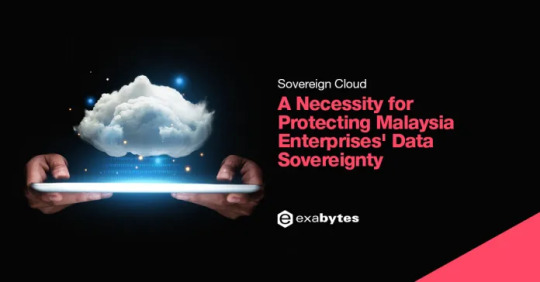
Trends of Sovereign Cloud in Malaysian Enterprises
Malaysia has taken proactive steps to uphold its digital sovereignty by implementing policies and frameworks designed to enhance data security. The regulatory framework in Malaysia includes the National Policy Objectives of the Communications and Multimedia Act 1998 and the Personal Data Protection Act 2010. These legal and policy instruments form a comprehensive cross-sectoral framework that safeguards personal data in commercial transactions, ensuring the security, integrity, and reliability of information, networks, and infrastructure. The importance of data sovereignty in Malaysia is further highlighted by the surging demand for secure, locally operated cloud services. As the threat continues to evolve, the need for robust data protection and the preservation of digital sovereignty has become increasingly urgent. The government has recognized the importance of creating and implementing systems to overcome these evolving threats.
Challenges of Using Sovereign Cloud
While sovereign cloud offers myriad benefits, it also presents several challenges, notably in data classification complexity. Organizations are tasked with identifying critical and sensitive data and ensuring compliance with national and regional security standards. Data classification involves organizing data into levels like public, confidential, or restricted, with distinctions often based on particular countries or regions. Moreover, diverse data types, such as national, corporate, or personal, may require different security approaches, making a thorough data and application assessment crucial.
Data sovereignty is the key focus of this innovative approach, signifying the authority and control a country or organization has over its data, regardless of where it’s stored or processed.
Let's Discover: What Is Sovereign Cloud and Why Is It Essential?
>> Click Here <<
Source from: www.exabytes.my/blog/sovereign-cloud-malaysian-enterprises/
0 notes
Text
AI’s energy use already represents as much as 20 percent of global data-center power demand, research published Thursday in the journal Joule shows. That demand from AI, the research states, could double by the end of this year, comprising nearly half of all total data-center electricity consumption worldwide, excluding the electricity used for bitcoin mining.
The new research is published in a commentary by Alex de Vries-Gao, the founder of Digiconomist, a research company that evaluates the environmental impact of technology. De Vries-Gao started Digiconomist in the late 2010s to explore the impact of bitcoin mining, another extremely energy-intensive activity, would have on the environment. Looking at AI, he says, has grown more urgent over the past few years because of the widespread adoption of ChatGPT and other large language models that use massive amounts of energy. According to his research, worldwide AI energy demand is now set to surpass demand from bitcoin mining by the end of this year.
“The money that bitcoin miners had to get to where they are today is peanuts compared to the money that Google and Microsoft and all these big tech companies are pouring in [to AI],” he says. “This is just escalating a lot faster, and it’s a much bigger threat.”
The development of AI is already having an impact on Big Tech’s climate goals. Tech giants have acknowledged in recent sustainability reports that AI is largely responsible for driving up their energy use. Google’s greenhouse gas emissions, for instance, have increased 48 percent since 2019, complicating the company’s goals of reaching net zero by 2030.
“As we further integrate AI into our products, reducing emissions may be challenging due to increasing energy demands from the greater intensity of AI compute,” Google’s 2024 sustainability report reads.
Last month, the International Energy Agency released a report finding that data centers made up 1.5 percent of global energy use in 2024—around 415 terrawatt-hours, a little less than the yearly energy demand of Saudi Arabia. This number is only set to get bigger: Data centers’ electricity consumption has grown four times faster than overall consumption in recent years, while the amount of investment in data centers has nearly doubled since 2022, driven largely by massive expansions to account for new AI capacity. Overall, the IEA predicted that data center electricity consumption will grow to more than 900 TWh by the end of the decade.
But there’s still a lot of unknowns about the share that AI, specifically, takes up in that current configuration of electricity use by data centers. Data centers power a variety of services—like hosting cloud services and providing online infrastructure—that aren’t necessarily linked to the energy-intensive activities of AI. Tech companies, meanwhile, largely keep the energy expenditure of their software and hardware private.
Some attempts to quantify AI’s energy consumption have started from the user side: calculating the amount of electricity that goes into a single ChatGPT search, for instance. De Vries-Gao decided to look, instead, at the supply chain, starting from the production side to get a more global picture.
The high computing demands of AI, De Vries-Gao says, creates a natural “bottleneck” in the current global supply chain around AI hardware, particularly around the Taiwan Semiconductor Manufacturing Company (TSMC), the undisputed leader in producing key hardware that can handle these needs. Companies like Nvidia outsource the production of their chips to TSMC, which also produces chips for other companies like Google and AMD. (Both TSMC and Nvidia declined to comment for this article.)
De Vries-Gao used analyst estimates, earnings call transcripts, and device details to put together an approximate estimate of TSMC’s production capacity. He then looked at publicly available electricity consumption profiles of AI hardware and estimates on utilization rates of that hardware—which can vary based on what it’s being used for—to arrive at a rough figure of just how much of global data-center demand is taken up by AI. De Vries-Gao calculates that without increased production, AI will consume up to 82 terrawatt-hours of electricity this year—roughly around the same as the annual electricity consumption of a country like Switzerland. If production capacity for AI hardware doubles this year, as analysts have projected it will, demand could increase at a similar rate, representing almost half of all data center demand by the end of the year.
Despite the amount of publicly available information used in the paper, a lot of what De Vries-Gao is doing is peering into a black box: We simply don’t know certain factors that affect AI’s energy consumption, like the utilization rates of every piece of AI hardware in the world or what machine learning activities they’re being used for, let alone how the industry might develop in the future.
Sasha Luccioni, an AI and energy researcher and the climate lead at open-source machine-learning platform Hugging Face, cautioned about leaning too hard on some of the conclusions of the new paper, given the amount of unknowns at play. Luccioni, who was not involved in this research, says that when it comes to truly calculating AI’s energy use, disclosure from tech giants is crucial.
“It’s because we don’t have the information that [researchers] have to do this,” she says. “That’s why the error bar is so huge.”
And tech companies do keep this information. In 2022, Google published a paper on machine learning and electricity use, noting that machine learning was “10%–15% of Google’s total energy use” from 2019 to 2021, and predicted that with best practices, “by 2030 total carbon emissions from training will reduce.” However, since that paper—which was released before Google Gemini’s debut in 2023—Google has not provided any more detailed information about how much electricity ML uses. (Google declined to comment for this story.)
“You really have to deep-dive into the semiconductor supply chain to be able to make any sensible statement about the energy demand of AI,” De Vries-Gao says. “If these big tech companies were just publishing the same information that Google was publishing three years ago, we would have a pretty good indicator” of AI’s energy use.
19 notes
·
View notes
Text
Hi there’s a tornado in my area rn but I’m spiteful like that. Random tsams/eaps headcanons be upon ye
Ruin still does those little audio log diaries. It helps manage his overflowing memory storage (read: old age = more memories to store) without compressing data files.
Bloodmoon sleeps with dog toys. Otherwise, they’d probably chew through whatever bedding material they had chosen that night. This was Ruin’s idea.
Eclipse can’t sleep with lights on in a room. Ruin can’t sleep without a light. The makeshift solution is a sleeping mask for Eclipse, but their actual compromise is a star projector.
Eclipse has to know where everyone is most of the time, especially after Charlie came into the picture. This is usually done with cameras and tracking via fazbear systems, but it’s an issue he has to work on, as it’s just a method to make him feel better about security now that there are people he cares about. At least one person has commented on there being a new nightguard.
Dark sun finds thrillers tacky, and prefers thought-provoking mysteries, bonus points for romance.
Most of them carry some kind of sanitizing wipe packet. For daycare attendants, these are for sticky messes and children. For those more familiar with tools, these are for tougher grime and are not suitable for sensitive (children’s) skin. Solar has both.
The eclipses (Eclipse, Solar, Ruin) are the most prone to damaging their rays. Eclipse sometimes hits doorways and doesn’t bother to fix cracked rays. Ruin is small enough for humans to reach his head. Solar peels the paint off of his. All three will pull or squeeze their rays in times of extreme stress, to varying degrees. Lunar is an exception for lack of rays. (Similarly, Sun fidgets with his rays, which is the source of this trait.)
While there are exceptions, Suns prefer tactile stimulation, Moons auditory, and Eclipses have no strong preference. Earth likes social interaction.
Animatronics have personalized UI that makes sense to them, which serves as their access point to their internal folders, like memory files, downloaded items, and executable programs. Bots that share an operating system/“brain” have the same UI. Diagnostics, software updates, and safety modes all require additional hardware (computers, parts and service devices, fazwrenches) to complete. Mindscapes are in AI chips, and multiple AIs in one mindscape happen when multiple AIs share the same operating system. Visual feed can be projected onto other screens with HDMI cables and vice versa, which can sometimes show that bot’s UI depending on what it is. For a more direct example of this think of the battery and blue borders you see in Security breach when Gregory is hiding inside Freddy.
Safety mode disconnects that bot from the Fazbear Ent. local network, meaning no tracking, no communication via local networks (which generally aren’t private anyway, most bots with access to phones prefer those), and no access to files that aren’t stored in that bot’s drive. This is meant to isolate a bot’s systems from the main network in case of a security breach (hah), make transportation of bots between locations easier, and make maintenance a smoother affair as there is no outside interference during the process. For the bots themselves, this is the equivalent of turning off your phone and going outside I mean focusing only on what’s in front of you instead of what’s going on in your area/social network. It’s possible to be stuck in safety mode. Depending on how much of a bot’s system relies on Fazbear Ent. Networks to function (such as a bot’s memory being stored in a Cloud, which is also ill advised between the bots themselves,) this can be mean a temporary personality/memory reset until those files get reconnected again. Bots do not need to be connected to the Fazbear ent networks to function, but it generally makes access to software updates easier due to being recognized as a company entity. It is possible for a private network to exist, but it’s considered foreign by Fazbear systems and can be more trouble than they’re worth. Moon and Eclipse have private networks shared with close friends and family for different purposes. Moon’s is mostly for emergency backups, and Eclipse’s is for security.
Animatronic’s memories are stored in the hard drives in their bodies. It’s possible to offload memory files into networks (Cloud) or external storage systems. If another bot had access to these clouds or external storages, they could experience the memories stored in them. Memory files include visual and auditory data, like a movie. AI/personality chips are the equivalent of a soul in that the AI is the product of a learning AI having experienced environments that supplied them information about the world AKA an Ai that developed a personality beyond their base programming, but they do not carry memories. For example, Eclipse V3-V4 is an Eclipse AI given incomplete memories, creating a disconnect in the AI’s learned behaviors and what it perceives as the source of that behavior, resulting in an incomplete backup. Backups are static/unchanging copies of integral memory files and the accompanying AI (As is in the moment that they are backed up.) Backups need to be updated as the animatronic it’s for develops.
#go easy on me I only have basic knowledge of computer stuff#quirky headcanons#tsams#eaps#I’m also halfway through a sociology class so take the AI one with a grain of salt#hopefully this makes sense
25 notes
·
View notes
Text
Wajahat Ali at The Left Hook:
Elon Musk showed the world that buying the U.S. presidency only costs about $300 million. This is like shopping at The Dollar Store for the world’s richest man. I grudgingly tip my hat to Musk, an immigrant, who is an aficionado of Nazi salutes much like his Hitler-supporting grandparents who moved to South Africa because they were inspired by the Apartheid regime. Musk’s $290 million was a small risk with a massive return on investment. Money alone didn’t move the needle. He also bought Twitter at a loss so he could take over a major social media site and use it to promote misinformation, conspiracy theories, and platform white supremacists and hate-mongers like Tommy Robinson and Nick Fuentes.
He went all-in with Donald Trump after saying he wouldn’t donate to any candidate because he realized Trump is an unethical criminal who would treat the Oval Office like an ATM. It’s all quid pro quo. Donald has returned the favor by allowing Musk to roam free around Mar-a-Lago, join phone calls with world leaders, dine with tech billionaires who bent the knee, and he even publicly thanked him for helping with those “vote counting computers” in Pennsylvania. So far, whatever Musk wants, he gets. Musk decided to torpedo the bipartisan government spending deal via Twitter and Republicans almost shut down the government to appease him. Musk went all-in with H1B visas and referred to MAGA who criticized him as “contemptible fools” and “retards,” and Trump did a 180 on the issue and sided with him.
So, why be content with just the appetizers? Why not raid the fridge and grab everything, including the cake, the cookies, and all the crumbs? Musk has a voracious appetite and the United States of America as his “all you can eat” buffet. As Donald Trump yells at the clouds and threatens to make Canada the 51st state for balking at “the dumbest trade war in history,” Musk is busy gaining access to all of our financial data. On Friday, David Lebryk, a top civil servant at the Treasury Department, was pushed out of his job after he refused to give DOGE, the Department of Government Efficiency headed by Musk, access to the system. Please note Musk is a private citizen and not a federal employee. We still don’t know the scope of DOGE’s role, its limits, its budget, its staff, or whether it will function as a department of the government or exist as an independent organization. What we do know is DOGE is behaving like a Trojan Horse and has allowed Elon Musk to gain access to the Treasury’s federal payment system, which includes every US taxpayer’s personal information. Through DOGE, Musk has promised to eliminate wasteful spending, which according to him includes ending DEI programs, “defanging” regulators like the Securities and Exchange Commission and FTC which have investigated his businesses, privatizing the US postal service, “deleting” the IRS, and ending remote work. However, he wants to improve defense spending, so he will continue receiving government subsidies for his SpaceX which will produce rockets that explode in the sky and give Americans the most expensive fireworks.
Another target on his chopping block is eliminating humanitarian spending. He’s accomplishing that goal by attacking USAID, which provides life-saving support to marginalized communities around the world. But to Musk, who loves the pro-Nazi AfD party, USAID is an “evil” and “criminal organization” that deserves to die. As of Sunday, USAID’s X account and website are no longer available. People around the world, such as children in Sudan, Gaza, and Ukraine, will die as a result of this cruel, unnecessary action, but, hey, none of that matters to the “pro-life” MAGA movement. On Saturday night, two top security officials from the agency were put on leave because they refused officials from DOGE access to private systems. Thanks to Musk’s interference, the head of the FAA was also forced to resign, which led to the United States being without an FAA chief during a preventable and tragic airline collision in DC that claimed nearly 70 lives. Musk didn’t appreciate Starlink being fined in 2022 for violations of safety protocols.
In two weeks’ time, the Co-”Presidency” of Elon Musk and Donald Trump has destroyed everything that made America great, as the broligarchy has taken over and plundered everything in sight.
See Also:
Let's Address This (Qasim Rashid): MAGAs 7 Deadly Sins—So Far—And How to Fight Back
America, America (Steven Beschloss): Bullies, Criminals and the Fight for America
#Elon Musk#Donald Trump#Trump Administration II#Broligarchy#DOGE#Department of Government Effiency#DEI#Diversity Equity and Inclusion#SpaceX#Treasury Department#David Lebryk#USAID#FAA#Potomac River Midair Collision#Musk Coup
23 notes
·
View notes
Text
Why I remain hopeful about America
Even as darkness falls
ROBERT REICH
JAN 20

Friends,
So many people I know — including, I suspect, many of you — are despairing over Trump’s second regime, which starts today.
I share your fears about what’s to come.
Yet I remain hopeful about the future of America. Here’s why.
Trump hoodwinked average working Americans into believing he’s on their side and convinced enough voters that Kamala Harris and Democrats were on the side of cultural elites (the “deep state,” “woke”ism, “coastal elites,” and so on).
But Trump’s hoax will not work for long, given the oligarchy’s conspicuous takeover of America under Trump II.
Even before Trump’s regime begins, it’s already exposing a reality that has been hidden from most Americans for decades: the oligarchy’s obscene wealth and its use of that wealth to gain power over America.
Seated prominently where Trump is giving his inaugural address today will be the three richest people in America — Elon Musk, Jeff Bezos, and Mark Zuckerberg — each of whom owns powerful media that have either boosted Trump’s lies or refrained from telling the truth about him.
Musk sank a quarter of a billion dollars into getting Trump elected, in return for which Trump has authorized him, along with billionaire Vivek Ramaswamy, to target for elimination programs Americans depend on — thereby making way for another giant tax cut for the wealthy.
The oligarchy’s conflicts of interest will be just as conspicuous.
Musk’s SpaceX is a major federal contractor through its rocket launches and its internet service, Starlink. Bezos’s Amazon is a major federal contractor through its cloud computing business. Zuckerberg is pouring billions into artificial intelligence, as is Musk, in hopes of huge federal contracts.
Ramaswamy, whose biotech company is valued at nearly $600 million, wants the Food and Drug Administration to speed up drug approvals. His investment firm has an oil and gas fund. His new Bitcoin business would benefit if the federal government kept its hands off crypto.
Trump himself has already begun to cash in on his second presidency even more blatantly than he did the first time. He just began selling a cryptocurrency token featuring an image of himself — even though cryptocurrency is regulated by the Securities and Exchange Commission, to which Trump has already said he’ll name a crypto advocate as chair.
Not to mention the billionaires Trump is putting in charge of key departments to decide on taxes and expenditures, tariffs and trade, even what young Americans learn — all of whom have brazen conflicts of interest.
They’ll all be on display today with Trump. Then, many will take their private jets to Davos, Switzerland, for the annual confab of the world’s most powerful CEOs and billionaires.
Not since the Gilded Age of the late 19th century has such vast wealth turned itself into such conspicuous displays of political power. Unapologetically, unashamedly, defiantly.
This flagrancy makes me hopeful. Why? Because Americans don’t abide aristocracy. We were founded in revolt against unaccountable power and wealth. We will not tolerate this barefaced takeover.
The backlash will be stunning.
I cannot tell you precisely how or when it will occur, but it will start in our communities when we protect the most vulnerable from the cruelties of the Trump regime, ensure that hardworking families aren’t torn apart, protect transgender and LGBTQ+ people, and help guard the safety of Trump’s political enemies.
We will see the backlash in the 2026 midterms and the 2028 presidential election, when Americans elect true leaders who care about working people and the common good.
And just as we did at the end of the first Gilded Age of the late 19th century when the oligarchy revealed its hubris and grandiosity, Americans will demand fundamental reforms: getting big money out of politics, taxing huge wealth, busting up or regulating giant corporations, making huge social media platforms accountable to the public rather than to a handful of multibillionaires.
Friends, we could not remain on the path we were on. The sludge had been thickening even under Democratic administrations. Systematic flaws have remained unaddressed. Inequalities have continued to widen. Corruption and bribery have worsened.
It’s tragic that America had to come to this point. A few years of another Trump regime, even worse than the first, will be hard on many people.
But as the oligarchy is conspicuously exposed, Americans will see as clearly as we did at the end of the first Gilded Age that we have no option but to take back power.
Only then can we continue the essential work of America: the pursuit of equality and prosperity for the many, not the few. The preservation and strengthening of a government of, by, and for the people.
23 notes
·
View notes
Text
2024 team sponsors recap!
this is completely irrelevant to F1 but i study and do these stuffs for a living sooo 😩😩 2023 sponsors are based on the sponsors that are there at the beginning of the season (new sponsors that join in the middle of the season will be classified as 2024's)
Mercedes AMG Petronas F1 Team:
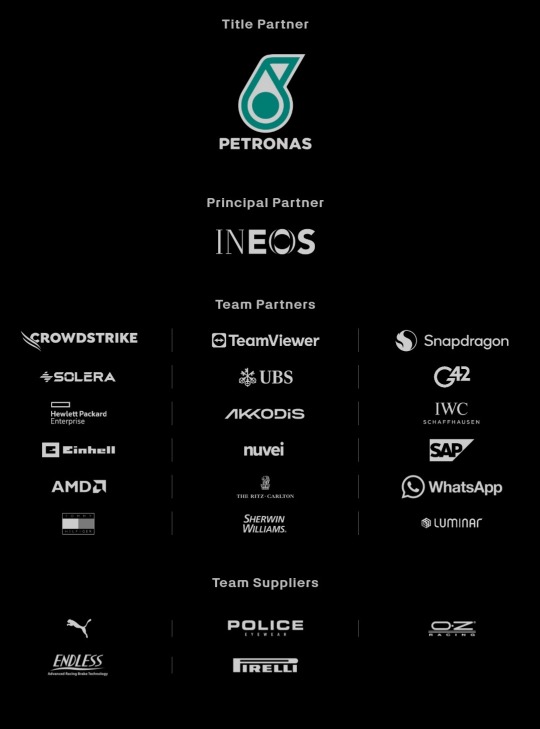
New sponsors: Whatsapp, Luminar (American tech company), SAP (German software company), nuvei (Canadian credit card services), Sherwin Williams (American painting company) 2024 data last update: 2024/02/14
Old sponsors that left: Monster Energy, Pure Storage (American technology company), fastly (American cloud computing services), Axalta (American painting company), Eight sleep (American mattresses company) 2023 data last update: 2023/01/07
Oracle Red Bull Racing F1 Team:
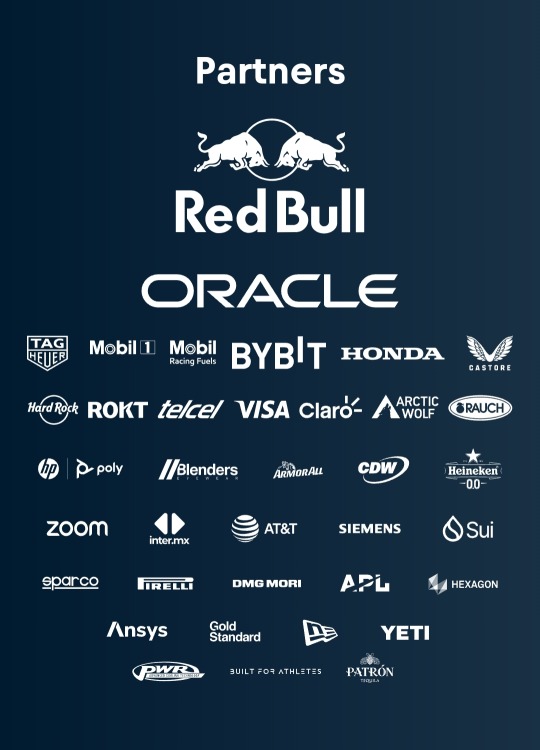
New sponsors: Yeti (American cooler manufacturer, joined later in 2023), APL (American footwear/athletic apparel manufacturer, joined later in 2023), CDW (American IT company, joined later in 2023), Sui (American tech app by Mysten Labs, joined later in 2023), Patron Tequila (Mexican alcoholic beverages company, joined later in 2023) 2024 data last update: 2024/02/15
Old sponsors that left: CashApp, Walmart, Therabody (American wellness technology company), Ocean Bottle (Norwegian reusable bottle manufacturer), PokerStars (Costa Rican gambling site), Alpha Tauri (? no info if they're official partners or not but Austrian clothing company made by Red Bull), BMC (Switzerland bicycle/cycling manufacturer), Esso (American fuel company, subsidiary of ExxonMobil), Hewlett Packard Enterprise (American technology company) 2023 data last update: 2023/03/07
More: Esso is a subsidiary of Mobil so there's possibility they merged or something
Scuderia Ferrari:
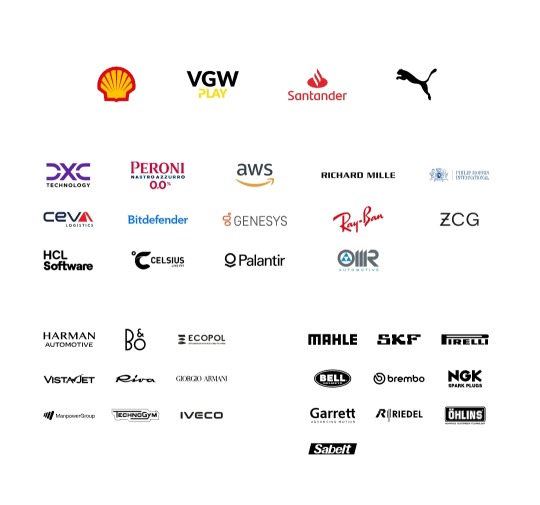
New sponsors: VGW Play (Australian tech game company, joined later in 2023), DXC Technology (American IT company, joined later in 2023), Peroni (Italian brewing company), Z Capital Group/ZCG (American private asset management/merchant bank company), Celsius (Swedish energy drink manufacturer) 2024 data last update: 2024/02/15
Old sponsors that left: Mission Winnow (American content lab by Phillip Morris International aka Marlboro), Estrella Garcia (Spanish alcoholic beverages manufacturer), Frecciarossa (Italian high speed train company) 2023 data last update: 2023/02/16
More: Mission Winnow is a part of Phillip Morris International. They are no longer listed as team sponsor but PMI is listed instead.
(starting here, 2023 data last update is 2023/02/23 and 2024 data last update is 2024/02/15)
McLaren F1 Team: (Only McLaren RACING's data is available idk if some of these are XE/FE team partners but anw..)
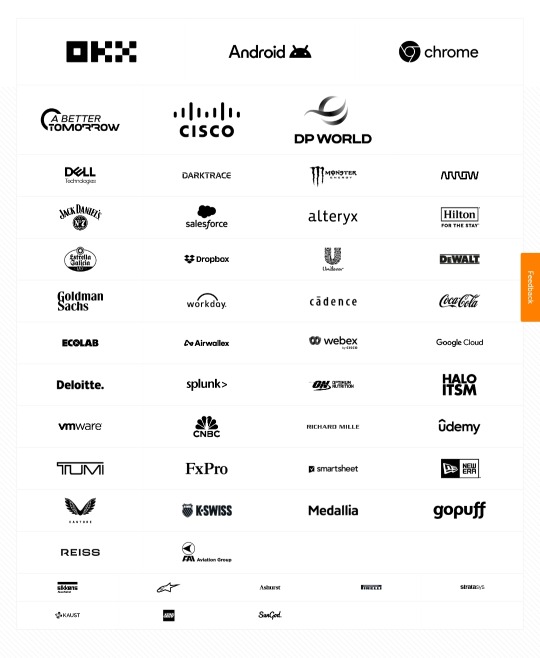
New sponsors: Monster Energy, Salesforce (American cloud based software company, joined later in 2023), Estrella Garcia (Spanish alcoholic beverages manufacturer), Dropbox (American file hosting company), Workday (American system software company, joined later in 2023), Ecolab (American water purification/hygiene company), Airwallex (Australian financial tech company), Optimum Nutrition (American nutritional supplement manufacturer), Halo ITSM (American software company, joined later in 2023), Udemy (American educational tech company, joined later in 2023), New Era (American cap manufacturer, joined in 2023), K-Swiss (American shoes manufacturer, joined later in 2023), Alpinestars (Italian motorsports safety equipment manufacturer)
Old sponsors that left: DP World (Emirati logistics company), EasyPost (American shipping API company), Immersive Labs (UK cybersecurity training company?), Logitech, Mind (UK mental health charity), PartyCasino (UK? online casino site), PartyPoker (American? gambling site), Sparco (Italian auto part & accessory manufacturer), Tezos (Switzerland crypto company)
Aston Martin Aramco F1 Team:

New sponsors: Valvoline (American retail automotives service company, joined later in 2023), NexGen (Canadian sustainable? fuel company), Banco Master (Brazilian digital banking platform, joined later in 2023), ServiceNow (American software company, joined later in 2023), Regent Seven Seas Cruise, Wolfgang Puck (Austrian-American chef and restaurant owner, joined later in 2023), Financial Times (British business newspaper), OMP (Italian racing safety equipment manufacturer), stichd (Netherlands fashion & apparel manufacturer)
Old sponsors that left: Alpinestars (Italian motorsports safety equipment manufacturer), crypto.com (Singaporean cryptocurrency company), ebb3 (UK? software company), Pelmark (UK fashion and apparel manufacturer), Peroni (Italian brewing company), Porto Seguro (Brazilian insurance company), Socios (Malta's blockchain-based platform), XP (Brazilian investment company)
Stake F1 Team (prev. Alfa Romeo):
???? Can't found their website (might be geoblocked in my country???)
BWT Alpine F1 Team:
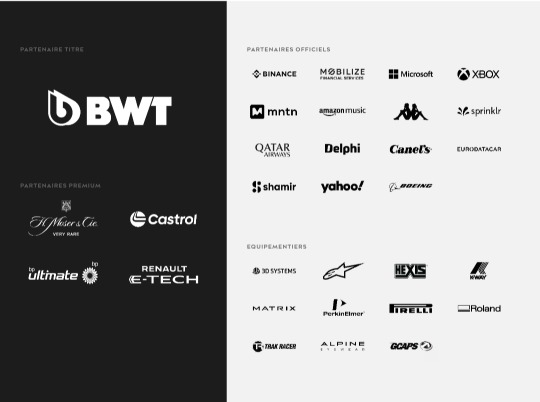
New sponsors: MNTN (American software company), H. Moser & Cie (Switzerland watch manufacturer), Amazon Music
Old sponsors that left: Bell & Ross (French watch company), Ecowatt (??? afaik French less-energy smthn smthn company), Elysium (French? American? Software company), KX (UK software company), Plug (American electrical equipment manufacturing company)
Visa CashApp RB F1 Team (prev. Scuderia Alpha Tauri):
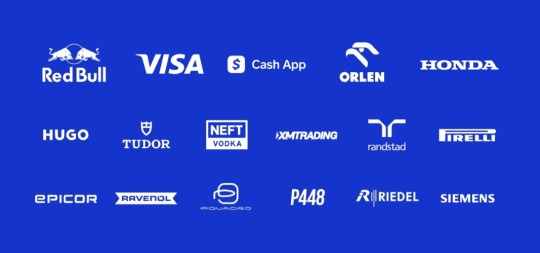
New Sponsors: Visa, CashApp, Hugo Boss, Tudor, Neft Vodka (Austrian alcoholic beverages company), Piquadro (Italian luxury bag manufacturer)
Old sponsors that left: Buzz (?), Carl Friedrik (UK travel goods manufacturer), Flex Box (Hongkong? shipping containers manufacturer), GMG (Emirati global wellbeing company), RapidAPI (American API company)
Haas F1 Team:

New sponsors: New Era (American cap manufacturer, joined later in 2023)
Old sponsors that left: Hantec Markets (Hongkong capital markets company), OpenSea (American NFT/Crypto company)
Williams Racing:

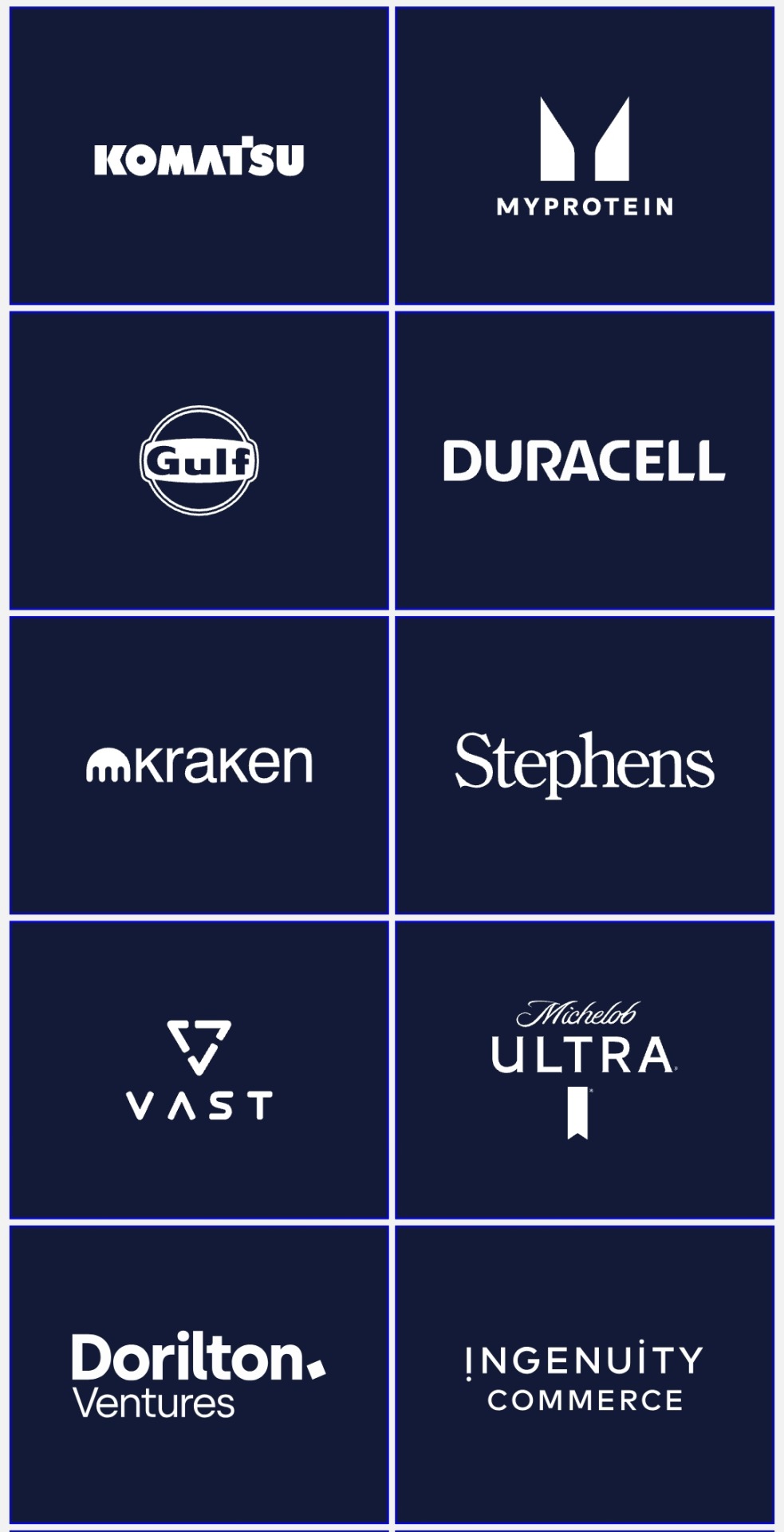
New sponsors: Komatsu, MyProtein (British bodybuilding supplement), Kraken (American crypto company, joined later in 2023), VAST Data (American tech company), Ingenuity Commerce (UK e-commerce platform), Puma (joined later in 2023)
Old sponsors that left: Acronis (Swiss software company), Bremont (British watch manufacturer), Dtex Systems (American? cybersecurity company), Financial Times (British business newspaper), Jumeirah Hotels & Resorts, KX (UK software company), OMP (Italian racing safety equipment manufacturer), PPG (American painting manufacturer), Umbro (English sports equipment manufacturer), Zeiss (German opticals/optometrics manufacturing company)
#mercedes amg petronas#red bull racing#scuderia ferrari#visa cash app rb#haas f1 team#mclaren f1#aston martin#alpine f1#williams racing#stake f1 team#f1#ari's rant#sponsor talks
42 notes
·
View notes
Text
Install your own OpenVPN on cloud now! Use UHost.
#scloud#cloud computing#virtual machine#private cloud services#cloud services#app development#openvpn#uhost#uvpc
0 notes
Text
What is Web Hosting? Discover Types, Key Factors, & 2024’s 12 Best Web Hosting Platforms.
Web hosting—the physical presence of your website on the internet—is essential for your online business. Without dependable web hosting, you jeopardize your capacity to run your business and meet your consumers’ expectations.
Understanding web hosting and how it works can be difficult, particularly for people who are unfamiliar with the notion. This article will clearly describe web hosting, explain the many types of web hosting plans available, and outline the essential factors to consider when selecting a hosting company.
What is web hosting?

Web hosting uses internet-facing hardware and software to provide web services to end users. It is where your website and services are stored, processed, and delivered.
At its most fundamental, web hosting consists of secure internet interfaces and communications, computer server hardware and storage, web server software, and content (text, pictures, audio/video).
However, most web hosting solutions also include database servers, content management systems, e-commerce tools, security and authentication, and other applications required for websites to function and remain secure.
The web hosting sector is critical and is expected to increase by more than 20% year between 2024 and 2028.
How much does web hosting cost?
Hosting charges vary, typically based on capabilities. You may pay $10 per month for a simple billboard-style website to market your business online, or much more if you run a successful e-commerce store with thousands of clients.
To successfully select web hosting that works for you, you simply need to understand your goals and how to translate them into hosting requirements.
Types of Web Hosting
Shared hosting.
Dedicated Hosting
VPS (Virtual Private Server) hosting
Cloud hosting
Continue Reading The Blog Post Click Here...
#Web Hosting#Hosting#WordPress Hosting#WP Hosting#Best Web Hosting#Web Hosting Platforms#Top 12 Web Hosting
7 notes
·
View notes
Text
What is Cybersecurity? Types, Uses, and Safety Tips
What is Cyber security?
Cyber security, also known as information security, is the practice of protecting computers, servers, networks, and data from cyberattacks. With the increasing reliance on technology in personal, professional, and business environments, the importance of cyber security has grown significantly. It helps protect sensitive data, ensures the integrity of systems, and prevents unauthorized access to confidential information.
For businesses in Jaipur, cyber security services play a crucial role in safeguarding digital assets. Whether you're an e-commerce platform, an IT company, or a local enterprise, implementing strong cyber security in Jaipur can help mitigate risks like hacking, phishing, and ransomware attacks.
Types of Cyber security
Cyber security is a vast domain that covers several specialized areas. Understanding these types can help individuals and organizations choose the right protection measures.
1. Network Security
Network security focuses on protecting the network infrastructure from unauthorized access, data breaches, and other threats. Tools like firewalls, virtual private networks (VPNs), and intrusion detection systems are commonly used. In Jaipur, many businesses invest in cyber security services in Jaipur to ensure their networks remain secure.
2. Information Security
This type of cyber security involves protecting data from unauthorized access, ensuring its confidentiality and integrity. Companies offering cyber security in Jaipur often emphasize securing sensitive customer and business information, adhering to global data protection standards.
3. Application Security
Application security addresses vulnerabilities in software and apps to prevent exploitation by cybercriminals. Regular updates, secure coding practices, and application testing are vital components.
4. Cloud Security
As more businesses move to cloud-based solutions, securing cloud environments has become essential. Cyber security providers in Jaipur specialize in offering services like data encryption and multi-factor authentication to ensure cloud data is safe.
5. Endpoint Security
Endpoint security protects devices such as laptops, desktops, and mobile phones from cyber threats. It is especially critical for remote work setups, where devices may be more vulnerable. Cyber security services in Jaipur provide solutions like antivirus software and mobile device management to secure endpoints.
6. IoT Security
With the rise of Internet of Things (IoT) devices, ensuring the security of connected devices has become crucial. Businesses in Jaipur use cyber security in Jaipur to secure smart devices like industrial sensors and home automation systems.
Uses of Cyber security
Cyber security is indispensable in various domains. From individual users to large organizations, its applications are widespread and critical.
1. Protection Against Cyber Threats
One of the primary uses of cyber security is to safeguard systems and data from threats like malware, ransomware, and phishing. Businesses in Jaipur often rely on cyber security Jaipur solutions to ensure they are prepared for evolving threats.
2. Ensuring Data Privacy
For industries like finance and healthcare, data privacy is non-negotiable. Cyber security measures help organizations comply with laws and protect sensitive customer information. Cyber security services in Jaipur ensure businesses meet data protection standards.
3. Business Continuity
Cyber security is essential for ensuring business continuity during and after cyberattacks. Jaipur businesses invest in robust cyber security services in Jaipur to avoid downtime and minimize financial losses.
4. Securing Financial Transactions
Cyber security ensures the safety of online transactions, a critical aspect for e-commerce platforms and fintech companies in Jaipur. Solutions like secure payment gateways and fraud detection tools are widely implemented.
5. Enhancing Customer Trust
By investing in cyber security in Jaipur, businesses build trust with their customers, demonstrating a commitment to safeguarding their data and transactions.
Cyber security in Jaipur
Jaipur is emerging as a hub for businesses and IT companies, which has increased the demand for reliable cyber security solutions. Cyber security services in Jaipur cater to diverse industries, including retail, healthcare, education, and finance.
Local providers of cyber security Jaipur solutions offer tailored services like:
Vulnerability Assessments: Identifying potential security risks in systems and networks.
Penetration Testing: Simulating attacks to uncover weaknesses and improve defenses.
Managed Security Services: Continuous monitoring and management of security operations.
Many IT firms prioritize cyber security services in Jaipur to ensure compliance with global standards and protect their operations from sophisticated cyber threats.
Safety Tips for Staying Secure Online
With the rising number of cyberattacks, individuals and businesses must adopt proactive measures to stay secure. Here are some practical tips that integrate cyber security in Jaipur into daily practices.
1. Use Strong Passwords
Ensure passwords are long, unique, and a mix of letters, numbers, and symbols. Avoid reusing passwords for multiple accounts. Cyber security experts in Jaipur recommend using password managers for added security.
2. Enable Two-Factor Authentication (2FA)
Adding an extra layer of security through 2FA significantly reduces the risk of unauthorized access. Many cyber security services in Jaipur emphasize implementing this measure for critical accounts.
3. Regular Software Updates
Outdated software can be a gateway for attackers. Keep operating systems, antivirus tools, and applications updated to close security loopholes. Businesses in Jaipur frequently rely on cyber security Jaipur providers to manage system updates.
4. Be Cautious with Emails
Phishing emails are a common attack vector. Avoid clicking on suspicious links or downloading unknown attachments. Cyber security in Jaipur often involves training employees to recognize and report phishing attempts.
5. Invest in Reliable Cyber security Services
Partnering with trusted cyber security services in Jaipur ensures robust protection against advanced threats. From endpoint protection to cloud security, these services help safeguard your digital assets.
6. Avoid Public Wi-Fi for Sensitive Transactions
Public Wi-Fi networks are vulnerable to attacks. Use a VPN when accessing sensitive accounts or conducting financial transactions. Cyber security Jaipur experts often provide VPN solutions to businesses and individuals.
7. Backup Your Data Regularly
Regularly backing up data ensures that critical information is not lost during cyber incidents. Cyber security providers in Jaipur recommend automated backup solutions to minimize risks.
Why Choose Cyber Security Services in Jaipur?
The vibrant business ecosystem in Jaipur has led to a growing need for specialized cyber security services. Local providers like 3Handshake understand the unique challenges faced by businesses in the region and offer customized solutions.
Some reasons to choose cyber security Jaipur services from like 3Handshake include:
Cost-Effective Solutions: Tailored to fit the budgets of small and medium-sized businesses.
Local Expertise: Providers have an in-depth understanding of regional cyber threats.
24/7 Support: Many companies offer round-the-clock monitoring and support to handle emergencies.
For businesses in Jaipur, investing in cyber security services in Jaipur is not just about compliance; it's about ensuring long-term success in a competitive digital landscape.
4 notes
·
View notes
Text
The end-to-end encrypted communication app WhatsApp, used by roughly 3 billion people around the world, will roll out cloud-based AI capabilities in the coming weeks that are designed to preserve WhatsApp’s defining security and privacy guarantees while offering users access to message summarization and composition tools.
Meta has been incorporating generative AI features across its services that are built on its open source large language model, Llama. And WhatsApp already incorporates a light blue circle that gives users access to the Meta AI assistant. But many users have balked at this addition, given that interactions with the AI assistant aren’t shielded from Meta the way end-to-end encrypted WhatsApp chats are. The new feature, dubbed Private Processing, is meant to address these concerns with what the company says is a carefully architected and purpose-built platform devoted to processing data for AI tasks without the information being accessible to Meta, WhatsApp, or any other party. While initial reviews by researchers of the scheme’s integrity have been positive, some note that the move toward AI features could ultimately put WhatsApp on a slippery slope.
“WhatsApp is targeted and looked at by lots of different researchers and threat actors. That means internally it has a well understood threat model,” says Meta security engineering director Chris Rohlf. “There's also an existing set of privacy expectations from users, so this wasn’t just about managing the expansion of that threat model and making sure the expectations for privacy and security were met—it was about careful consideration of the user experience and making this opt-in.”
End-to-end encrypted communications are only accessible to the sender and receiver, or the people in a group chat. The service provider, in this case WhatsApp and its parent company Meta, is boxed out by design and can’t access users’ messages or calls. This setup is incompatible with typical generative AI platforms that run large language models on cloud servers and need access to users’ requests and data for processing. The goal of Private Processing is to create an alternate framework through which the privacy and security guarantees of end-to-end encrypted communication can be upheld while incorporating AI.
Users opt into using WhatsApp’s AI features, and they can also prevent people they’re chatting with from using the AI features in shared communications by turning on a new WhatsApp control known as “Advanced Chat Privacy.”
“When the setting is on, you can block others from exporting chats, auto-downloading media to their phone, and using messages for AI features,” WhatsApp wrote in a blog post last week. Like disappearing messages, anyone in a chat can turn Advanced Chat Privacy on and off—which is recorded for all to see—so participants just need to be mindful of any adjustments.
Private Processing is built with special hardware that isolates sensitive data in a “Trusted Execution Environment,” a siloed, locked-down region of a processor. The system is built to process and retain data for the minimum amount of time possible and is designed grind to a halt and send alerts if it detects any tampering or adjustments. WhatsApp is already inviting third-party audits of different components of the system and will make it part of the Meta bug bounty program to encourage the security community to submit information about flaws and potential vulnerabilities. Meta also says that, ultimately, it plans to make the components of Private Processing open source, both for expanded verification of its security and privacy guarantees and to make it easier for others to build similar services.
Last year, Apple debuted a similar scheme, known as Private Cloud Compute, for its Apple Intelligence AI platform. And users can turn the service on in Apple’s end-to-end encrypted communication app, Messages, to generate message summaries and compose “Smart Reply” messages on both iPhones and Macs.
Looking at Private Cloud Compute and Private Processing side by side is like comparing, well, Apple(s) and oranges, though. Apple’s Private Cloud Compute underpins all of Apple Intelligence everywhere it can be applied. Private Processing, on the other hand, was purpose-built for WhatsApp and doesn’t underpin Meta’s AI features more broadly. Apple Intelligence is also designed to do as much AI processing as possible on-device and only send requests to the Private Cloud Compute infrastructure when necessary. Since such “on device” or “local” processing requires powerful hardware, Apple only designed Apple Intelligence to run at all on its recent generations of mobile hardware. Old iPhones and iPads will never support Apple Intelligence.
Apple is a manufacturer of high-end smartphones and other hardware, while Meta is a software company, and has about 3 billion users who have all types of smartphones, including old and low-end devices. Rohlf and Colin Clemmons, one of the Private Processing lead engineers, say that it wasn’t feasible to design AI features for WhatsApp that could run locally on the spectrum of devices WhatsApp serves. Instead, WhatsApp focused on designing Private Processing to be as unhelpful as possible to attackers if it were to be breached.
“The design is one of risk minimization,” Clemmons says. “We want to minimize the value of compromising the system.”
The whole effort raises a more basic question, though, about why a secure communication platform like WhatsApp needs to offer AI features at all. Meta is adamant, though, that users expect the features at this point and will go wherever they have to to get them.
“Many people want to use AI tools to help them when they are messaging,” WhatsApp head Will Cathcart told WIRED in an email. “We think building a private way to do that is important, because people shouldn’t have to switch to a less-private platform to have the functionality they need.”
“Any end-to-end encrypted system that uses off-device AI inference is going to be riskier than a pure end to end system. You’re sending data to a computer in a data center, and that machine sees your private texts,” says Matt Green, a Johns Hopkins cryptographer who previewed some of the privacy guarantees of Private Processing, but hasn’t audited the complete system. “I believe WhatsApp when they say that they’ve designed this to be as secure as possible, and I believe them when they say that they can’t read your texts. But I also think there are risks here. More private data will go off device, and the machines that process this data will be a target for hackers and nation state adversaries.”
WhatsApp says, too, that beyond basic AI features like text summarization and writing suggestions, Private Processing will hopefully create a foundation for expanding into more complicated and involved AI features in the future that involve processing, and potentially storing, more data.
As Green puts it, “Given all the crazy things people use secure messengers for, any and all of this will make the Private Processing computers into a very big target.”
3 notes
·
View notes